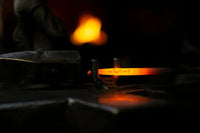Choosing the right material is critical for any design, construction, or architectural project. Wrought iron and steel are two of the most commonly used metals, each offering unique strengths and applications. However, without a clear understanding of their differences, it’s easy to make a choice that doesn’t suit your project’s needs.
In this article, I’ll break down the key distinctions between wrought iron and steel—covering composition, strength, aesthetics, and cost—so you can make an informed decision that enhances both the performance and longevity of your design.
Wrought Iron vs Steel: Understanding the Main Difference
The main difference between the two comes down to composition: wrought iron has very low carbon content, making it softer and easier to work with, whereas steel’s higher carbon levels give it increased strength and rigidity. Simply put, wrought iron excels in aesthetics and craftsmanship, while steel is all about power and precision. It’s a bit like comparing a master blacksmith to a cutting-edge architect—both have their place, depending on what you’re building.
What is Wrought Iron?
Wrought iron, one of the oldest metals used by humans, is known for its low carbon content and fibrous texture, which make it easy to shape into those classic, ornate designs you often see in gates and railings. The term “wrought” means “worked,” highlighting the traditional process of heating and hammering the metal repeatedly to achieve its final form.
What is Steel?
Steel, however, took the spotlight in the 19th century thanks to advancements in mass production. Unlike wrought iron, steel is created by adding carbon and other elements to iron, resulting in a much stronger and more versatile material. This additional strength is why steel is the backbone of modern construction and industrial applications, while wrought iron is more at home in decorative and artistic roles.
Composition and Manufacturing Differences of Wrought Iron and Steel
The key differences between wrought iron and steel start right at the manufacturing stage. Wrought iron is produced using a process that focuses on purification and refining. Raw iron is heated and repeatedly hammered to remove impurities, giving the material its unique grainy texture and malleability. This technique results in a softer, more ductile metal that’s perfect for creating intricate designs and decorative elements. Essentially, it’s the artisan’s metal—a throwback to a time when patience and craftsmanship were at the core of production.
Steel, on the other hand, takes a more scientific approach. The process begins with alloying, where iron is combined with varying amounts of carbon and other elements like chromium or nickel to enhance strength and resistance.
The result? Different types of steel, such as carbon steel and stainless steel, each tailored for specific uses. Steel’s higher carbon content compared to wrought iron gives it increased hardness and durability, making it the go-to material for modern construction and industrial applications.

Physical and Mechanical Properties vs. Aesthetic and Design Potential
When comparing wrought iron and steel, their physical properties go hand-in-hand with their aesthetic possibilities. Wrought iron, with its low tensile strength and high malleability, is easier to bend and shape without compromising its integrity. This makes it the preferred choice for creating detailed, artistic elements like scrolls and curves in gates, railings, and decorative pieces. Its natural grainy texture adds visual appeal, giving a handcrafted feel that’s hard to replicate. However, it’s not the strongest material out there and can be prone to wear and bending under high stress—more suitable for form than heavy-duty function.
Steel offers significantly higher tensile strength and resistance to bending, making it the backbone of structural elements that need to endure weight and pressure. Its wear-resistance is exceptional, which is why steel is the default choice for high-stress applications like beams and columns. But strength doesn’t mean sacrificing design. Steel’s flexibility in terms of customizability—think powder coating for surface finishes and precision welding for intricate shapes—means it can still deliver on aesthetics. It’s just that where wrought iron is like sculpting with clay, steel is more like chiseling stone: tougher to work with, but capable of achieving remarkable detail with the right techniques.
Wrought Iron or Steel—Are You Getting What You Pay For?
When it comes to selecting between wrought iron and steel, cost is a major factor that can influence your decision. Let’s break down what you need to consider while keeping the best interests of your project.
Wrought iron is generally more expensive due to its labor-intensive manufacturing process and the higher price point for raw materials. This cost also extends to installation, as the material’s malleability often requires specialized skills for custom designs.
Steel tends to be more budget-friendly, especially for large-scale projects. Its mass production and versatility make it easier to work with, reducing both manufacturing and installation costs.

If your project prioritizes aesthetics and artistic detail—like in ornamental railings or custom gates—wrought iron’s long-term value and timeless appeal can justify the upfront investment. Steel also offers a better return on investment for structural applications, where strength and durability are paramount. For example, if you’re constructing a load-bearing staircase or a balcony railing exposed to heavy use, steel’s robust performance makes it a clear winner.









